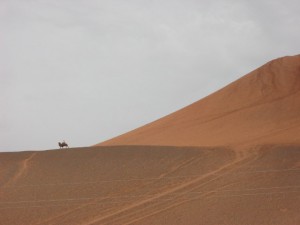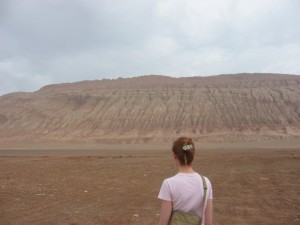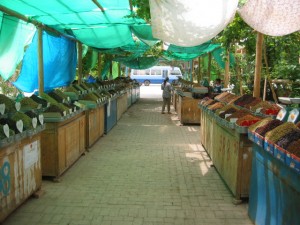The Taklamakan Desert in western China was the Bermuda Triangle of the Silk Road. The word Taklamakan literally means– Once you go in, you don’t come out. It is still a wasteland. The military tests its nuclear weapons there and they just discovered huge deposits of oil underneath. For thousands of years, the oasis towns ringing the desert have witnessed the rise and fall of civilizations. They have been influenced by Greeks, Arabs, Turks, Indians, and Chinese. We visited one of them.
After a long bus ride, we arrived in Turpan at night. After hours of desolate scenery, it was strange to see thousands of people milling about outside, eating and socializing. It had a festive and friendly county fair vibe. I later learned that people are outside at night because it is so damn hot during the day.
We spent our first night in a brand new hotel. The concrete had barely dried. The dining hall, where we had a traditional Han Chinese breakfast, was soulless and institutional. We got out of there quick.
We strolled through town, looking for a driver/guide. We find a young-ish Uyghur with a 1980s white Nissan Maxima. Though we don’t share a language in common, we made a deal. First up on the itinerary– the Flaming Mountains!
The Flaming Mountains got their name because it’s regularly over 120 degrees there, they’re red like fire, and the folds look like the outline of flames. The domestic tourism industry is burgeoning and a busload of Han Chinese tourists get off next to us. One by one, they take pictures next to a mangy, tired Bactrian camel with colorful bows and ribbons tied all over it. I later learn that the camel would die of exhaustion.
Next to the Flaming Mountains are the Bezeklik Buddist Caves. The site contains 77 caves and they’re filled with murals of Buddha. They date from the 5th century.
Unfortunately, they are a mess. Muslims scratched out every one of the thousands of faces.
At the turn of the 20th century, German archaeologists chiseled away entire walls of murals for museums at home. When the Allies bombed Germany during World War II, many of the murals were destroyed.
Next, we visited the abandoned city of Gaochang. It was founded in the first century, B.C., and was a major stop along the Silk Road. One ethnic group after another ruled the metropolis. Nestorian Christians and Buddhists lived side by side before the Arabs came and converted everyone.
This donkey cart driver conned us. He promised a tour of the ruins. We agreed on a price. Only when we were out in the middle of nowhere did he remind me that we would have to pay him again for the return trip.
Back in Turpan, we learn why the city is known for its grapes. The streets are lined and covered with trellises. Just look at all those different colored raisins!
We end our jaunt with a visit to the Emin Minaret. It was built in 1777 and is similar to minarets in nearby Afghanistan. Again, as a part of the new tourism industry, the Chinese have spent a lot of money “improving”/destroying historical sites. In an effort to refresh it, the minaret looks brand new and kind of shoddily built. It’s as if they razed the structure and just built a cheap copy on its foundations. It’s quite sad.
Images source: Maxichamp








